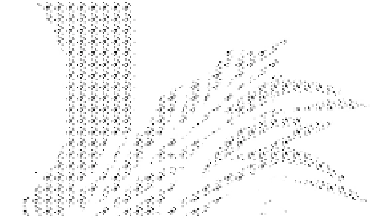Biomedical Engineering Reference
In-Depth Information
12.4.3.3 Spreader
For a wide dispersion of fuel over the bed, spreader wheels are used
(
Figure 12.19
). The spreader throws the fuel received from a screw or other
type of metering feeder over a large area of the bed surface. Typically, it
comprises a pair of blades rotating at high speed; slightly opposite orienta-
tion of the blades helps throw the fuel over a larger lateral area. This is not a
metering device. A major problem with the spreader is that it encourages
segregation of particles in the bed.
12.4.3.4 Pneumatic Injection Feeder
A pneumatic injection feeder is not a metering device; rather, it helps feed
already metered biomass into the reactor. This works well for gravity feed-
ing, and it is especially suitable for fine solids. Pneumatic injection is pre-
ferred for less reactive fuels, which must reside in a gasifier bed longer, for
complete conversion. It transports dry fuel particles in an air stream at a
velocity higher than their settling velocity. The fuel is typically fed from
underneath a bubbling fluidized bed. The maximum velocity of air in the
fuel transport lines may not exceed 11
15 m/s to avoid line erosion. The air
for transporting constitutes part of the air for gasification.
Splitting of the fuel
air mixture into multiple fuel lines is a major prob-
lem with pneumatic injection. A specially designed feed splitter, like pneu-
matic or fluidized splitters (Basu, 2006, p. 355), can be used.
In an underbed pneumatic system, air jets that carry solid particles with
high momentum to enter into the fluidized bed, form a plume that could
punch through the bed. To avoid this, a cap sits at the top of the exit of each
feeder nozzle. This cap reduces the momentum of the jets breaking into the
Gasifier / combuster
FIGURE 12.19
Rotary spreader for spreading the fuel over a large bed area.

















Search WWH ::

Custom Search